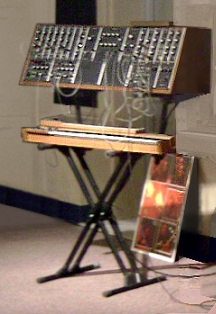
| Version | Summary | Created by | Modification | Content Size | Created at | Operation |
|---|---|---|---|---|---|---|
| 1 | Camila Xu | -- | 1397 | 2022-09-30 01:39:36 |
Video Upload Options
A Moog modular synthesizer is a monophonic analog modular synthesizer developed by the American electronic instrument pioneer Dr. Robert Moog. Many different models were manufactured by R.A. Moog Co. (Moog Music after 1972) from 1965–80.
1. History
In 1964, Robert Moog created one of the first modular voltage-controlled music synthesizers, and demonstrated it at the AES convention that year. Moog employed his theremin company to manufacture and market his synthesizers which, unlike the synthesizers created by Don Buchla (the other prominent figure in the early history of the synthesizer), featured a piano-style keyboard as a significant portion of the user interface. Moog also established standards for analog synthesizer control interfacing, with a logarithmic one volt-per-octave pitch control and a separate pulse triggering signal.
The first Moog system was bought by choreographer Alwin Nikolais. Lothar and the Hand People began using the modular Moog in 1965. Composers Eric Siday and Chris Swansen were also among the first customers, with Paul Beaver and Micky Dolenz used the Moog on The Monkees fourth album, Pisces, Aquarius, Capricorn & Jones Ltd., released in November 1967. Dolenz' use of the Moog on Daily Nightly highlighted the Moog's ability to add atmosphere to a recording, while Beaver's use of it on Star Collector was more straightforward. It was Wendy Carlos' 1968 Switched-On Bach which featured Carlos' custom-built modular synthesizer as the only instrument on the recording which brought widespread interest to the Moog synthesizer. Shortly after, Keith Emerson, Jan Hammer, Klaus Schulze, Tangerine Dream, The Beatles, and The Rolling Stones also became owners of modular Moogs. This new popularity led to the 1970 release of the classic Minimoog and subsequent Moog synthesizers, modeled after the larger modular systems and designed for portability, usability, and affordability. A number of universities purchased Moog systems or modules; the University of Iowa where composer Peter Tod Lewis was a faculty member, for example, owned a Moog Modular IIIC with an optional double-sequencer addition.
2. Basics
The Moog modular system consists of a number of various modules mounted in a cabinet. Each module performs a specific signal-generating or -modifying function. These modules offered unprecedented control over creating sounds by allowing a user to modify primary sound waveforms (sine waves, square waves and other waveforms provided by voltage controlled oscillators or VCO) with amplitude modulators (voltage controlled amplifiers or VCA) and spectral modulators (voltage controlled filters (VCF) or fixed filter banks) and other modifiers. Envelope generators provided further control by modulating the attack, decay, sustain and release (ADSR) parameters of the VCAs, VCFs and other modules. The modules are patched together with patch cords with ¼-inch mono plugs. The patch cords and module parameter knobs could be adjusted in countless ways to create a nearly infinite number of sounds. The final sound was heard ('triggered') from the system by pressing a key on an attached keyboard or pressing on the ribbon controller.
The Moog modular synthesizer offered musicians a revolutionary new way to produce sound when it was released in the 1960s. It was originally intended for use in recording studios and universities and was not intended for (or widely embraced by) musicians for use in live performance. The analog electronics of the system often made sound generation unreliable and unpredictable during live performances. For example, the VCOs were notorious for their inability to hold a fixed frequency for any extended period of time and would often change pitch and go out of tune, especially in hot or damp environments. Additionally, modular sounds could not be programmed and stored for retrieval due to the instrument's analog nature. Changing sounds on the system was a time-consuming task requiring the physical re-routing of numerous patch cords and manual knob adjustments.
Another common problem is the Moog's incompatibility with the gate/trigger voltage used in most other synthesizers of the time. Moog equipment used a high-state logic called S-trig, which maintained at +8-10 volts until the trigger was sent, dropping the voltage to 0, the opposite of what was commonly used by other manufacturers. In addition to this incompatibility, if a certain patch used an extensive amount of triggering connections, each module would cause a voltage drop sending the logic over into low-state and firing the S-trigger. In spite of all its shortcomings, a few artists (including Emerson, Lake & Palmer, Klaus Schulze, Tangerine Dream, and Hideki Matsutake with the Yellow Magic Orchestra) successfully toured with Moog modular systems.
3. Models
In the early and experimental days of electronic instruments, R.A Moog Co. sold made-to-order synthesizer systems composed of whatever modules the musician desired. Starting in 1967, the company began manufacturing a number of pre-assembled stock modular systems that contained a predetermined number of modules. Later on, these systems were manufactured and modified based on customer specifications. Produced from 1967–72, the earliest Moog modular systems were named the Moog 3, Moog 2, and Moog 1. The "C" series featured solid walnut cabinets and, starting in 1970, the "P" series, designed for portability, came in a road case. From 1971 to 1973, the Moog 10 and the Moog 12 were manufactured, each mounted in a road case. Produced from 1972 to 1981, the Moog 15, the Moog 35 and the Moog 55 featured walnut cabinets like the earlier "C" series. Moog also produced the Moog Co-ordinated Electronic Music Studio ( C.E.M.S.).[3][4]
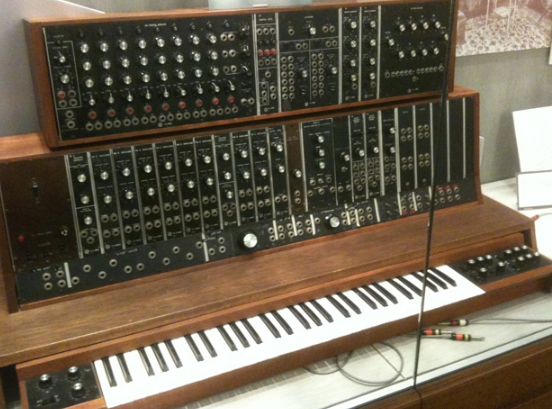
1st commercial Moog (1964)
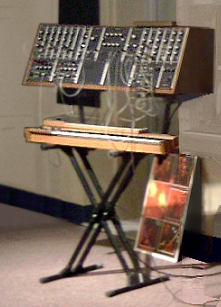
Moog 1C (1965, demo)
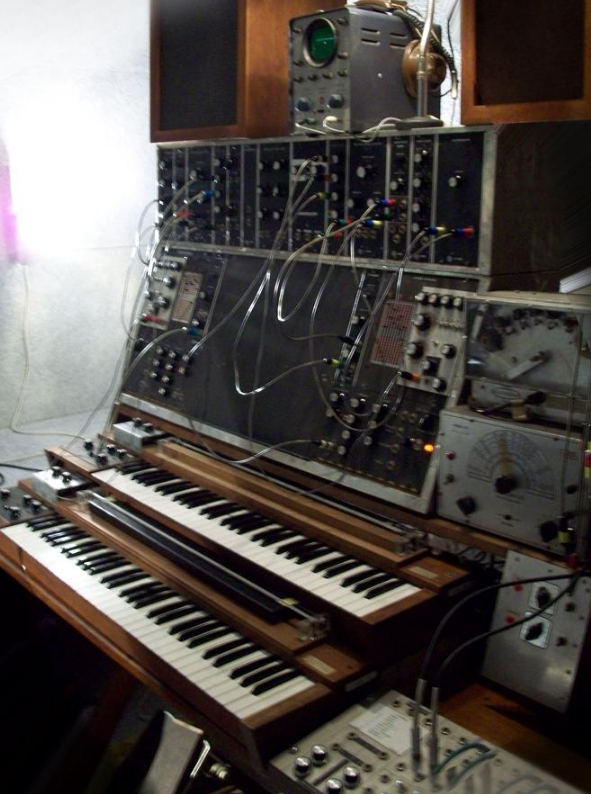
Max Brand Synthesizer (1968, custom made)

Moog 3P (1970)
with sequencer (right)
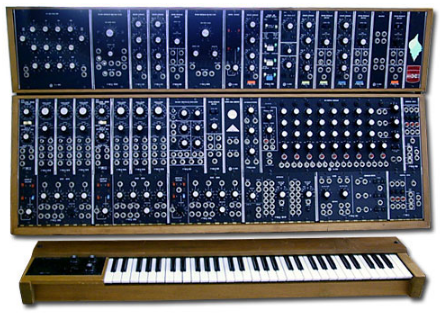
Moog 55 (1974)
VST software manufacturer Arturia has released Moog Modular V, a PC software version of the Moog modular system. It is currently the only software version of the instrument, and the first of Arturia's two Moog simulations to be approved by Moog.
4. Modules
The following is a list of modules manufactured by Moog. Many modules were designed to replace existing ones.
- 901 – VCO/LFO
- 901A – VCO driver (1 volt per octave)
- 901B – VCO
- 901C – VCO output stage (used on early systems)
- 901D – VCO output stage
- 902 – VCA (2 inputs, 2 outputs, 3 CV inputs)
- 903 – white noise (used on early systems before 903A)
- 903A – random signal generator (white or pink noise)
- 904A – low-pass VCF (24 dB-per-octave, considered the classic Moog filter)
- 904B – high-pass VCF
- 904C – filter coupler
- 905 – spring reverb
- 907 – horizontal fixed filter bank (Moog 10 and Moog 12)
- 907A – vertical fixed filter bank (Moog 15 and Moog 35)
- 909 – power supply (Early units)
- 910 – power supply (Early units)
- 911 – ADSR envelope generator (adjustable from 2 ms to 10 seconds)
- 911A – dual trigger delay
- 912 – envelope follower
- 914 – fixed filter bank (12-band, 125 Hz to 5 kHz, with high-pass and low-pass knobs)
- 921 – VCO (1.01 Hz to 40 kHz)
- 921A – VCO driver (1 volt per octave)
- 921B – VCO (more stable than 901B)
- 923 – noise, high-pass and low-pass filter
- 928 – sample and hold
- 930 – power supply (Later units)
- 950 – 49-note keyboard
- 950A – keyboard controller
- 950B – scale programmer
- 951 – 61-note keyboard
- 952 – 49-note, duophonic keyboard
- 955 – ribbon controller (replaced by 956)
- 956 – ribbon controller
- 958 – pedal controller
- 959 – joystick (X-Y) controller
- 960 – sequencer (3 rows of eight steps)
- 961 – sequencer interface Include voltage-trigger to S-trigger and back
- 961CP – sequencer interface panel (Moog 55)
- 962 – sequential switch
- 984 – 4X4 matrix mixer
- 991 – filter and attenuator
- 992 – control voltages (illuminated red or blue switches linked to the 904A)
- 993 – trigger/envelope (illuminated yellow or green switches)
- 994 – jack multiples (duplicates voltages)
- 995 – attenuators
- 1120 – foot pedal
- 1125 – sample-and-hold
- 1130 – drum controller
- 1131 – percussion controller
- 1150 – ribbon controller
- 1630 – Bode Frequency Shifter (designed by Harald Bode)
- 1634 – pitch-to-voltage converter
- 6401 – Bode ring modulator (designed by Harald Bode)
- 6402 – Bode dual ring modulator (designed by Harald Bode)
- 6552 – Bode Frequency Shifter with external carrier (designed by Harald Bode)
- CP1 – CV and trigger outputs (Moog 3P)
- CP2 – CV and trigger outputs, and filters
- CP3 – 4X1 mixer
- CP3A – mixer (illuminated switches linked to the VCOs)
- CP4 – CV and trigger outputs, attenuators (Moog 1C)
- CP4A – CV and trigger outputs (Moog 35)
- CP5 – CV and trigger outputs (designed for the "P" series)
- CP6 – CV and trigger outputs (designed for the "P" series)
- CP7 – CV and trigger outputs, multiples (designed for the "P" series)
- CP8 – power switch (Moog 2C and Moog 3C)
- CP8A – power switch (Moog 35 and Moog 55)
- CP9 – power switch (Moog 3P)
- CP11 – mixer, triggers, outputs (Moog 10; four-input mixer, jack multiples, attenuator, 2 CV and trigger outputs, and 2 audio outputs)
- CP35 – attenuators (Moog 35)
- In addition to these, Moog made four preset boxes for the First Moog Quartet performance in Carnegie Hall (ca. 1967). Keith Emerson used a preset box for his Moog Modular. Each box contained perhaps six cards, each card with a lighted pushbutton to enable its presets to be active. Screwdriver-adjusted trimming pots on the cards were connected, by photoconductive cells on the cards, directly to the module circuits (knobs were set at their limits). The synthesizers were small portable 900-series modular types.
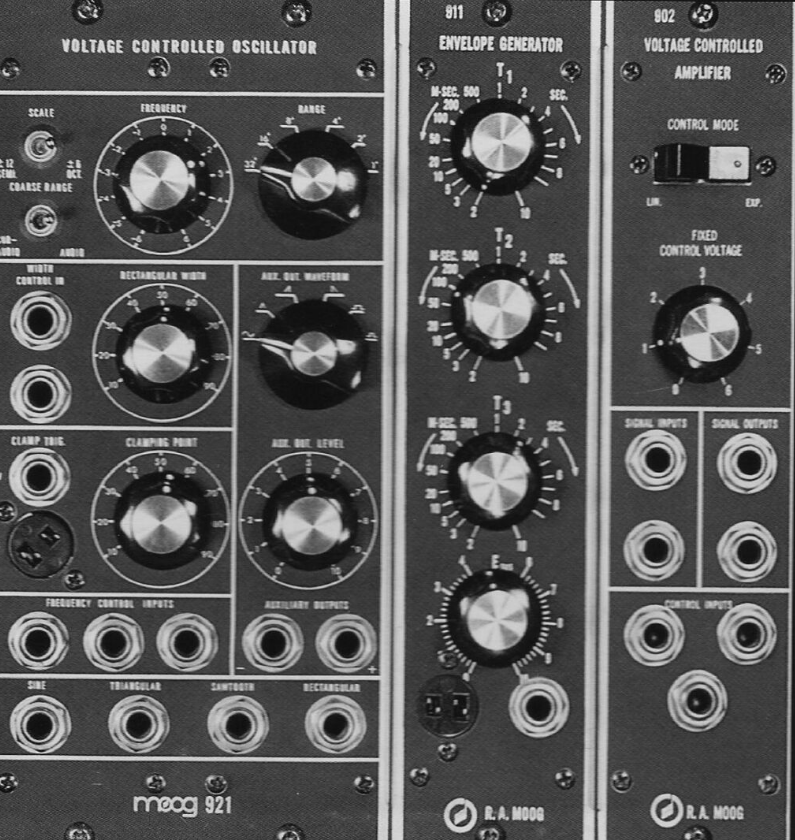
References
- "Collection Checklists". Cantos Music Foundation. Archived from the original on 2010-08-12. https://web.archive.org/web/20100812075405/http://www.cantos.ca/explore/collection-checklist#synth. 1CA Chris Swanson Modular System (1965) displayed at Cantos Music Foundation
- Sue Metzger (Mar 17, 1970). "Inventor Makes Electronic Music". Cornell Daily Sun. http://www.bobmoog.com/1970/03-17.htm. Chris Swanson, who played this instrument, was a musician-composer employed by R.A.Moog Inc/R.A.Moog Co. at the time.
- Dean, Roger T. (2009). "Hardware Digital Synthesizers and How They Developed". The Oxford Handbook of Computer Music. Oxford University Press. p. 58. ISBN 978-0-19-533161-5. "in 1969, the Coordinated Electronic Music Studio (CESM) system was conceived by Joel Chadabe and built by Moog. This was a programmable analog synthesis system that had an automated matrix mixer and a digital clock. It was installed at the Electronic Music Studio at the State University of New York at Albany." https://books.google.com/books?id=AuwvREYWOMEC&pg=PA58
- "Moog-CEMS unique original custom modular". Sphere France sarl. http://www.spheremusic.com/Bargaindtl.asp?Item=5560. "Joel Chadabe's book 'Electric Sound' pp286-287: 'In 1966, I got an idea. I drew up a plan for a completely automated synthesizer system, discussed its feasibility with Robert Moog, described it in an article in 'New Perspectives in Music', and got the funding to have it built. That system, which I called the CEMS (Coordinated Electronic Music Studio) System, was ordered from Moog in 1967.... and installed in December 1969.' ... For more of the old pics see: https://www.flickr.com/photos/8429881@N06/sets/72157602899680757/"


